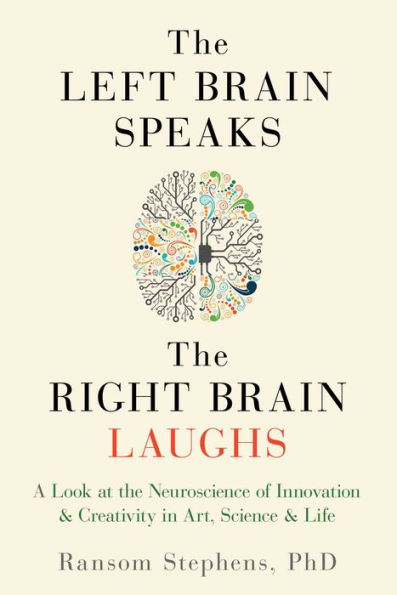

eBook
Available on Compatible NOOK devices, the free NOOK App and in My Digital Library.
Related collections and offers
Overview

Product Details
| ISBN-13: | 9781632280473 |
|---|---|
| Publisher: | Viva Editions |
| Publication date: | 11/08/2016 |
| Sold by: | SIMON & SCHUSTER |
| Format: | eBook |
| Pages: | 252 |
| File size: | 2 MB |
About the Author
Ransom Stephens is a physicist, technologist, and novelist. He’s written over 400 articles on subjects ranging from quantum physics to parenting teenagers and produces events for Litquake. His first novel, The God Patent, was “the first debut novel to emerge from the new paradigm of online publishing” according to the San Francisco Chronicle. He lives in Petaluma, CA.
Table of Contents
1 You & Me 1
1.1 Peeling the ignorance onion 4
1.2 Left & right 5
1.2.1 A new and improved left-right oversimplification 7
1.2.2 Sorting out the left-right dichotomy 9
1.3 The picture within a picture 12
1.4 What are we doing here? 13
2 Animals & People 15
2.1 Different perspectives on reality 16
2.2 Evolution 18
2.2.1 The power of long times and large numbers 19
2.2.2 Evolution predicts what already happened 20
2.3 A frog, a puppy, and Richard Feynman walk into your cranium 21
2.3.1 First dose of jargon: neurons, axons, dendrites, and synapses 22
2.3.2 Your inner puppy and inner Feynman 24
2.4 How to greet a saber-toothed tiger … or chess player 27
2.4.1 Reaction timescales 31
2.4.2 Positive and negative feedback 32
2.5 The reality interface 35
2.5.1 The inescapably subjective nature of our realities 36
2.5.2 The realities of whales, dogs, and trees (and naked people) 37
2.6 The power of perspective 41
3 Life & Death 43
3.1 Emergence 45
3.2 Being alive and awake 47
3.2.1 Your stupid, bottom-up, parallel, unconscious processors 48
3.2.2 Your brilliant, top-down, serial, conscious thinkers 52
3.3 We are pattern-recognizers and model-builders 54
3.3.1 First impressions 56
3.3.2 Prejudice 57
3.4 How come novels work? 58
3.4.1 Theory of mind 59
3.5 Sentience and consciousness 60
3.5.1 Consciousness threshold 61
3.5.2 Consciousness spectrum 62
3.6 Free will 64
3.7 The essential weirdness of death 66
3.8 Good, fast, or cheap: pick two 68
4 Talent & Skill 69
4.1 Talent 70
4.1.1 Whence talent? 71
4.1.2 Skill 72
4.2 Like ringin' a bell 73
4.2.1 The wetware 73
4.2.2 The signal 75
4.2.3 The transition from playing notes to playing music 77
4.3 Talent or skill? 78
4.3.1 Neural pruning and synesthesia 79
4.3.2 Brain size 80
4.3.3 Perfect pitch: talent or skill? 81
4.4 Nature & nurture 82
4.5 Prodigies 85
4.5.1 Child prodigies 88
4.5.2 Adult prodigies 89
4.6 Skalent fuel 90
5 Intelligence & Intuition 93
5.1 We can't separate intellect and emotion 96
5.2 Learning 97
5.2.1 Recipes and algorithms 99
5.2.2 Plasticity 101
5.2.3 Education 102
5.2.4 Memory 103
5.2.5 Answer resolution 105
5.3 Thinking with your guts 106
5.3.1 The feeling of knowing 108
5.3.2 Priming 109
5.4 Priming your guts 112
6 Analysis & Creativity 115
6.1 The canyon floor and the mountain peak 116
6.2 Tools for thought 117
6.2.1 The binding problem 118
6.2.2 Reduction of the inconceivable 120
6.2.3 Words 123
6.2.4 Mental tools-the power of scratch paper 125
6.3 Lateral thought 127
6.3.1 Synesthesia 130
6.3.2 Neural resonance, coherence, and flow 132
6.3.3 Language as spatial resonance 134
6.3.4 Releasing your inner savant 136
6.4 Creativity 137
6.4.1 People use tools to analyze and create 138
7 Alone & Together 141
7.1 I was a loner until I wrote this chapter 143
7.2 Are we a hive? 144
7.2.1 The death of my inner rugged individualist 145
7.2.2 Extending the consciousness feedback loop to others 146
7.2.3 Imitation and simulation 147
7.2.4 Well, are we? 149
7.3 Value 153
7.3.1 The creator and the beholder 154
7.3.2 Engagement and novelty 155
7.3.3 Our subjectivity has a lot in common 157
7.3.4 Right people, right place, and right time 159
7.3.5 Common sense is neither 161
7.4 Does friendship define us? 164
7.5 Significance 166
8 Art & Science 169
8.1 The good, the bad, and the valuable 171
8.2 In it for the buzz 171
8.2.1 The glorious hopelessness of art and science 172
8.3 Neuroaesthetics in art and science: Ramachandran's rules 175
8.3.1 Ramachandran's rule of grouping-dissonance to consonance 176
8.3.2 Ramachandran's rule of peak shift-exaggeration 179
8.3.3 Ramachandran's rule of contrast-boundaries 180
8.3.4 Ramachandran's rule of isolation-heuristics and approximation 181
8.3.5 Ramachandran's rule of peekaboo-bait 182
8.3.6 Ramachandran's rule of abhorrence of coincidence-bullshit meter 183
8.3.7 Ramachandran's rules of orderliness and symmetry 184
8.3.8 Ramachandran's rule of metaphor 187
8.3.9 Ambiguity 190
8.4 Veronica 191
8.4.1 How music works 191
8.4.2 Elvis Costello's "Veronica" 193
8.4.3 Musical resonance 195
8.5 Art & science 196
8.5.1 Good work if you can get it 197
8.6 We have a lot of subjectivity in common 197
9 Innovation & Discovery 199
9.1 Facing challenges 202
9.2 Making better use of our brains 202
9.2.1 The quest 203
9.2.2 Stress and focus 206
9.2.3 Defocusing into insight 209
9.2.4 Meditation and prejudice 212
9.2.5 Perspective-altering techniques 213
9.2.6 Insight comes half-baked 215
9.3 Invention & discovery 216
9.4 Finding the pony 217
10 Staring at a Picture within a Picture within a Picture 221
10.1 Left-right, down-up, front-back 222
10.2 Obsessive pattern predictors need lots of education 223
10.3 The neuroscience onion 224
10.3.1 Neuroscience has issues 225
10.3.2 Neuroscience's dark matter problems 227
10.3.3 Experimental difficulties 228
10.3.4 Skepticism is warranted 229
10.4 So here we are 230
11 Bibliography 233
11.1 Recommended related reading 234
11.2 Other stuff that showed up here 238
From the Author 241
Acknowledgments 242
Note to You 244
